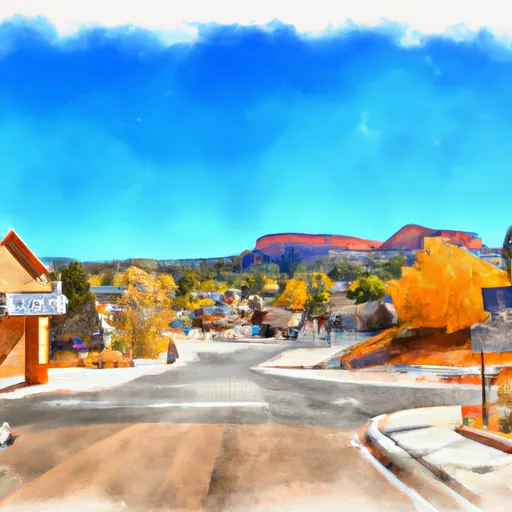-
 Snoflo Premium
Snoflo Premium
Get unlimited access to all our content
With no Ad interruptions! - Start Your Free Trial Login with existing account
Bryce
Eden Index
Climate
7.0
•
Recreation
4.5
•
Community
•
Safeguard
4.3/10

Bryce, Utah is a small town located near Bryce Canyon National Park. The area experiences a semi-arid climate with hot summers and cold winters. The hydrology in the area is characterized by intermittent streams and springs, and the primary water source is the Sevier River. Outdoor recreation opportunities abound in Bryce, including hiking, camping, rock climbing, and horseback riding in the national park. Visitors can also explore the nearby Grand Staircase-Escalante National Monument, which boasts over 1 million acres of wilderness and stunning geological formations. Other popular activities include mountain biking, ATV riding, and snowshoeing in the winter months. Overall, Bryce is a beautiful and unique destination for nature lovers and outdoor enthusiasts.
What is the Eden Index?
The Snoflo Eden Index serves as a comprehensive rating system for regions, evaluating their desirability through a holistic assessment of climate health, outdoor recreation opportunities, and natural disaster risk, acknowledging the profound impact of these factors on livability and well-being.
Climate Health Indicator (CHI): 7.0
Bryce receives approximately
408mm of rain per year,
with humidity levels near 64%
and air temperatures averaging around
6°C.
Bryce has a plant hardyness factor of
5, meaning
plants and agriculture in this region thrive during a short period during spring and early summer. Most
plants will die off during the colder winter months.
By considering the ideal temperature range, reliable water supplies, clean air, and stable seasonal rain or snowpacks, the Climate Health Indicator (CHI) underscores the significance of a healthy climate as the foundation for quality living.
A healthy climate is paramount for ensuring a high quality of life and livability in a region, fostering both physical well-being and environmental harmony. This can be characterized by ideal temperatures, reliable access to water supplies, clean air, and consistent seasonal rain or snowpacks.
Weather Forecast
Streamflow Conditions
Escalante Desert-Sevier Lake
Area Rivers
Escalante Desert-Sevier Lake
Snowpack Depths
Escalante Desert-Sevier Lake
Reservoir Storage Capacity
Escalante Desert-Sevier Lake
Groundwater Levels
Recreational Opportunity Index (ROI): 4.5
The Recreational Opportunity Index (ROI) recognizes the value of outdoor recreational options, such as parks, hiking trails, camping sites, and fishing spots, while acknowledging that climate plays a pivotal role in ensuring the comfort and consistency of these experiences.
Access to outdoor recreational opportunities, encompassing activities such as parks, hiking, camping, and fishing, is crucial for overall well-being, and the climate plays a pivotal role in enabling and enhancing these experiences, ensuring that individuals can engage in nature-based activities comfortably and consistently.
Camping Areas
| Campground | Campsites | Reservations | Toilets | Showers | Elevation |
|---|---|---|---|---|---|
| Kitchen Corral Wash - Grand Staircase Nat Mon | None | 5,344 ft | |||
| Otter Creek State Park | 30 | 6,375 ft | |||
| Fishermans Bench - Otter Creek Reservoir | None | 6,419 ft | |||
| Sunset - Bryce National Park | 101 | 8,007 ft | |||
| Buckskin Gulch - House Rock Valley | None | 4,822 ft | |||
| King Creek | 109 | 7,916 ft | |||
| North - Bryce National Park | 107 | 7,932 ft |
Catastrophe Safeguard Index (CSI):
The Catastrophe Safeguard Index (CSI) recognizes that natural disaster risk, encompassing floods, fires, hurricanes, and tornadoes, can drastically affect safety and the overall appeal of an area.
The level of natural disaster risk in a region significantly affects safety and the overall livability, with climate change amplifying these risks by potentially increasing the frequency and intensity of events like floods, fires, hurricanes, and tornadoes, thereby posing substantial challenges to community resilience and well-being.
Community Resilience Indicator (CRI):
The Community Resilience Indicator (CRI) recognizes that education, healthcare, and socioeconomics are crucial to the well-being of a region. The CRI acknowledges the profound impact of these elements on residents' overall quality of life. By evaluating educational resources, healthcare accessibility, and economic inclusivity, the index captures the essential aspects that contribute to a thriving community, fostering resident satisfaction, equity, and social cohesion.

